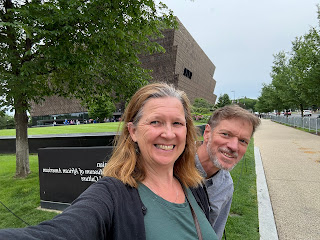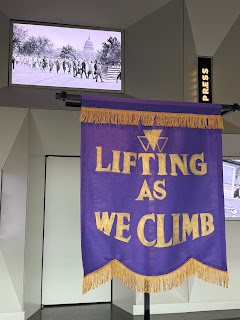Hearing rumors that the Smithsonian's National Museum of African American History and Culture (NMAAHC) will be closing. The story reported a month ago was more about African American history being whitewashed as artifacts that had been on loan since the museum opened in 2016 are being returned to their owners. These include Nat Turner's bible. The executive order issued in March 2025 was to remove funding for programs with "divisive narratives" and "improper ideology" specifically citing the NMAAHC and the Women's History Museum.
As we are learning, presidential executive orders are not the same as official laws.
I still wanted to visit the museum. It has been on my wish list since it opened nearly a decade ago, but it didn't push its way to the top until it was in the news. Strike that, I forgot about it until I saw it last October on a road trip home from North Carolina when we paused in DC and I walked past it on the gorgeous fall day.
Yesterday's weather as drizzly and grey. Some might say a good day to visit a museum.
Not knowing what time we would arrive in DC, I made a 2:30 reservation thinking three hours would be enough time to explore all of it. I was wrong. We arrived around noon and asked if we could go in early. Since they still had plenty of slots for the day, we were allowed in early.
We started our trip with lunch in the Sweet Home Café. Someone recently told us their favorite two museums food courts are in the National Museum of the American Indian and NMAAHC. We knew we liked the former, so we set our taste buds for Southern home cooking. The cafeteria is expensive (our meals were each $22), but considering the museum is free to attend, it was a good way to support their hard work.
Along the back wall of the dining hall is a replica of the famous Greensboro Woolworth's lunch counter. That reminded me I had heard the lunch counter was removed from the NMAAHC, a claim that was soon repudiated because the counter has been in the National Museum of American History for many years and is still there. The African American Museum has two original stools which are not always on display at the same time as often one is being maintained. We saw both of them on our visit. I thought about eating there, but did not.
On the surface, the museum does not look that imposing. It is only four stories and from the street level, it does not look that big.
After eating we popped into what I thought was a small room. That small room led to a large elevator which took us down three flights to the exhibit Slavery and Freedom, 1400-1877.
As Christopher Columbus did not "discover" America until 1492, and this is a museum about African American History and Culture, I wasn't sure why the 19th Smithsonian museum started back this far. It was later explained to me by an older African American gentleman at the front desk the museum wanted to start with some home and how it all started. The focus of the museum is not white guilt, but Black pride.
There were several school groups, making it hard to walk around the exhibits. Don really felt for one pre-teen boy who I saw reading the first panel of the first exhibit by putting his finger on each word as he read them. "There are a lot of words here!" he exclaimed. Yes, dude, there are.
When I came back from a restroom break I told Don I was concerned I wouldn't be able to find him. He not untruthfully said we are about the only white people there. As we walked through the museum, we saw more, mostly people about our age (it was a weekday during the school year). Our friendly docent encouraged us to tell our friends about the museum and encourage you to visit. Consider this your invitation.
The bottommost level (C3) is hard. Images of captives chained together in the hull of a ship with no room to stretch, or live, are hard to study. That's without the sounds and the smells. The stories of men being chained together and waking to find the person they are attached to dead are chilling. And that's the beginning. Once on land they are separated as they are sold. They did nothing to deserve this. A picture of Harriet Tubman in her old age shows a tiny woman who made an enormous difference in this world. The tiny shack that started its life in the 18th century as a slave cabin (and was donated to the museum when they opened in 2016) was no bigger than the room I am sitting in as I type, but in which a dozen people would have rested after toiling all day.
After spending at least half an hour in the very first room on the very first floor I encouraged Don to pick up the pace. Yes, we can come back someday, but it has taken us nine years to visit we needed to try to see more.

segregation 1876-1968 is not any easier. It is the same footprint of the lowest floor. The floor has a segregated railroad car. Behind us were two African American teenage girls on a school trip. The path takes you through the Whites Only car first before going to the smaller Colored Section. The girls said "Oohh...we wouldn't be allowed in here" as they admired the lounge area in the two whites only bathrooms and the space for extra luggage. They also said the colored section was pretty nice by today's standards and they wouldn't mind traveling in there. The fare was the same for both ends of the train.
 |
| Why do you need a lounge in a railcar bathroom? |
 |
| Whites Only seating |
 |
| The Colored bathroom still looks nicer than what is on trains today |
 |
| Colored seating |
 |
| View from the back of the train |
This was the separate but equal stage.
Behind the train car was a room with disturbing images and a warning. The Emmett Till Memorial. If you don't know anything about Emmett Till please read up on the 14-year old boy from Chicago who was beaten, kidnapped, shot, and thrown in the river as trash while visiting his family in a small town in Mississippi in the summer of 1955. His mother insisted his body be returned to Chicago where it was on public display. His brutal murder is one of the sparks of the Civil Rights Movement. I had heard of him before, but I did not realize this is what encouraged Rosa Parks to refuse to give up her seat a few months later.
On this floor we saw the two original Woolworth counter stools.
Takeaway: the fight for what is right is not quick. Keep it up!
The top basement floor (C2) is called A Changing America: 1968 and beyond. It is the smallest floor. It skipped through the most recent decades. I was not prepared for the tears when I heard President Obama's voice shake as he said if he had a son, he would look like Trayvon Martin, the 17-year old Black youth murdered in Florida in 2012.
Will we ever again have a President who has empathy?
If the Sweet Home Cafe was still open, they closed at 3 and it was 3:30 by the time we finished the basement levels, we would have paused for chocolate cake. Instead we took a deep breath and went to the information desk for a map. This was when we got into a conversation about traveling back in time to stop Pope Nicholas V from signing his Dum Diversas legalizing turning African citizens into lifetime slaves.
The main floor has no exhibits. Levels 2, 3, and 4 are much smaller than the basement. We learned buildings are not allowed to be taller than the Washington Monument, therefore they built this one underground. They chose this location because it is the site of a creek (since paved over) that was where the slave trade was held during the Colonial era. The museum goes under the street. As the museum guide is not to scale, I don't know how far it goes. We know it at least goes to the fountain we could see underground.
I decided to start at the top and end on the first floor. The upper most floor has the culture galleries, including movies, television. visual arts, cultural expressions, and music. Filled with eyepoppingly beautiful exhibits. After slavery and its aftermath, it felt like we could breathe again as we appreciated the Black pride on exhibit. Still, some white guilt is there as you see how long it took for Black actors to become more than sidekicks or play subservient roles.
Visit.
Learn about the past through a different lens than the one you grew up believing was the only one. The right one.
People matter.
I need to revisit that list I drew up in 2016 and visit more places. In the past nine years, I have only visited the Holocaust Museum and Newseum.





















































